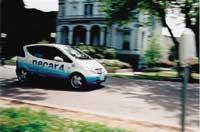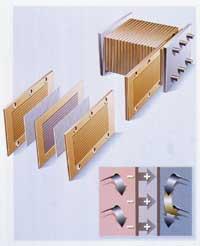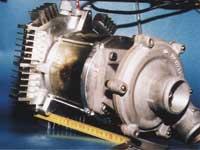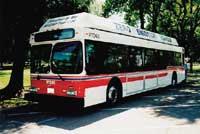Quite green and inexhaustible
paths will be tested, but the future will be that of hydrogen energy cells.”

In Europe, one of the least populated and at the same time colder countries, an energy revolution is taking place. Iceland wants to be the first state to abandon fossil fuels in the hydrogen economy in twenty years.
Water will be your main resource. According to energy experts, this strategy can turn 270,000 inhabitants of this state into the XXI. Worldwide energy slope in the middle of the century. The implementation of this strategy worldwide would prevent global warming.

Iceland has already made the way to banish fossil energies. Its electrical energy is mainly hydroelectric and uses geothermal energy to heat buildings. Now they want the transportation system to stop the servitude of oil. Hydrogen will be the new source of energy. It will be obtained by the fragmentation of water molecules, for which abundant hydroelectric energy will be used. Hydrogen will be liquefied and powered by cars, buses, trucks and electric fishing boats attached to energy cells. After a few years, Icelandic hydrogen is sold at 'gas stations' around the world.
The process began in February. Leading global energy cell companies and the government of Iceland signed a contract to conduct a national experiment. The participants are: the car manufacturer Daimler-Chrysler, which will prototype the vehicle; the oil company Shell, which in January has inaugurated its first hydrogen refueling station in Hamburg; Norks Hydro, the Norwegian hydroelectric company, and the energy cell designer Ballard Power System, from Canadian Vancouver.

Daimler-Chrysler energy cell buses, which are now testing in Chicago and Vancouver, are scheduled to circulate shortly in Reykjavik. 'The first hydrogen buses will circulate in our streets in a few months,' says Hjalmar Arnasa, a member of the Icelandic Parliament and president of the Icelandic Hydrogen Commission. This commission has been constituted by the Government and companies of Iceland. The next step is the supply of energy cells to fishing boats and the supply of trucks and cars.
According to Arnalson, within eighteen months the first hydrogen fishing companies would work: 'I'm optimistic, but at age 15 I've stayed with all the fleets being transformed.' Last year, the Icelandic government designed a plan for the management of the hydrogen economy leaving fossil fuels between 15 and 20 years.
Energy from hydrogen energy cells has been evolving for a long time. The first steps were taken in 1839 when Welsh physicist William Grove showed that the union of oxygen and hydrogen in the cell containing platinum electrodes produces electricity. The first practical energy cells were developed in the American space program. In the modern energy cell the platinum electrode removes electrons from hydrogen. The hydrogen ions that form go through the electrolyte to the other electrode. Electrons are trapped in the outer circuit and combined with hydrogen ions and oxygen produce water and electricity.

Vehicles that use energy cells barely produce noises and also do not generate contaminants associated with the use of fossil fuels: nitrogen oxides and carbon dioxide. At leakage only water vapor flows. The main problems of this technology are the cost, the difficulty in storing liquid hydrogen safely and the storage capacity of hydrogen sufficient for relatively long journeys. However, as emission controls become more stringent, energy cells will become increasingly attractive.

Christopher Flavin, an energy expert at
the Worldwatch Institute in Washington, says energy cells will revolutionize energy supply. However, he also makes an observation: 'The biggest job will be to develop a hydrogen transport and storage system.'

Buses and taxis that circulate through energy cells have already been tested. On the other hand, cars have space problems to store hydrogen, making them more difficult to design. Last March Damlier-Chrysler presented the fourth prototype of electric cars, called NECAR-4. Based on the five-seat Mercedes, you can travel 400 km without filling the fuel tank again.
Hydrogen is hard to store. Therefore, the previous prototype, called NECAR-3, carried methanol as fuel and methanol formed hydrogen by an existing reformer. This hybrid technology developed by Shell dissociates methanol to supply hydrogen and carbon dioxide.
Like other
large oil companies, Shell is looking for new products for two main reasons: reducing greenhouse gas emissions and reducing existing oil reserves. Shell sees methanol technology as a step towards hydrogen energy.
'Shell believes that hydrogen will be the fuel of the long-term future,' explains Herman Kuipers, head of a Shell research section. 'We are at the top of the oil age, but at the same time, at the beginning of the hydrogen era. The transition will be confusing and many technological paths will be tested (transformation of fossil fuels into hydrogen methanol, manufacture of hybrid engines, etc. ). ), but the future will be that of hydrogen energy cells.'

According to Ferdinand Panik, head of the energy cell section of Daimler-Chrysler, by the end of this year it will be decided whether mass production of NECAR-3 or -4 will begin. The manager of the same company, Jürgen Schrempp, said that at the end of this year will decide if so and that by 2004 will be manufactured 40,000 vehicles each year. The other car companies do not want to stay behind. Many collaborate with Ballard. 'Corporate incentives are so big that I think technical problems are going to be solved,' says Kuipers
Hydrogen can bring energy not only to vehicles, but also to many other things. Norks Hydro studies: Construction in Norway of two hydrogen thermal power plants using $2 billion. The company aims to obtain hydrogen from the North Sea methane. The carbon dioxide generated in the process would be injected into the soil for accumulation.

Meanwhile, Iceland is a good place to test the hydrogen economy. Being a small and rich island and without its fleet of vehicles being physically related to others, it is in a more favorable situation than any other country to embark on the path of hydrogen. It is also a good opportunity for the ecological production of fuel and its subsequent export.
Water can come from an energy source suitable for dissociation. However, the use of oil or coal would not be fair, since dependence on them would not be avoided. Renewable energies are the most suitable and Iceland is abundant. It is a rainy village with rivers and streams of great current. Currently it uses only one-tenth of its hydroelectric capacity. 'The road to Iceland could be a pioneering example in sustainable economy and industrial development,' says Panik.
Not all environmentalists are so much in agreement with the hydrogen economy. Some consider it a technological path without solution. It takes a lot of energy to produce and store hydrogen. Greenpeace in Germany has still said that the Icelandic project is a 'publicity stunt'.

In Britain, on the contrary, there are more positive positions.In the words of Tony Juniper of Friends of the Earth, 'the biggest attraction of hydrogen is to help solve the problem of air quality in cities'. 'If done with renewable energy, then it will be really attractive.'
Hydrogen
can be a powerful way to transport it from remote places, such as the Arctic rivers, to places where there is great energy demand. It seems that the day Iceland fills us with hydrogen instead of filling the fuel tank with Gulf gasoline is not so far from what we think.






